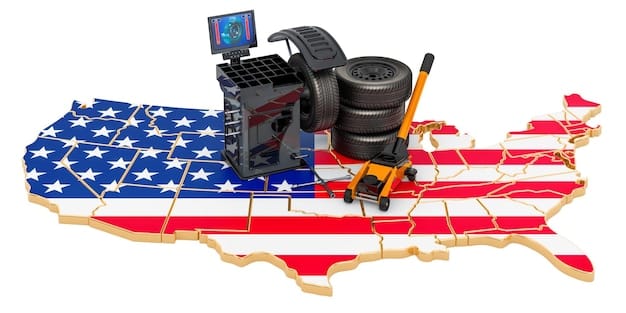Impact of 10% Tariff on US Car Manufacturers: An Analysis

Analyzing the impact of the 10% tariff increase on imported auto parts on US car manufacturers reveals potential increases in production costs, shifts in sourcing strategies, and subsequent effects on consumer prices and industry competitiveness.
The US automotive industry is a complex ecosystem, heavily reliant on a global supply chain. A significant portion of the components used in American-made vehicles are sourced from overseas. **Analyzing the impact of the 10% tariff increase on imported auto parts on US car manufacturers** requires a deep dive into potential shifts in the industry and how these may affect consumers.
Understanding the Auto Parts Tariff Landscape
The automotive industry’s global nature means tariffs on imported auto parts can have far-reaching consequences. These tariffs, essentially taxes on imported goods, are designed to protect domestic industries and encourage local production.
However, the reality is considerably more nuanced. The modern car is a complex machine assembled from thousands of parts sourced from around the globe. When tariffs are imposed on these parts, US car manufacturers can face increased costs, which could affect prices and profitability.
Historical Context of Auto Part Tariffs
Auto part tariffs are not a new phenomenon. Throughout history, various administrations have used tariffs to protect domestic industries, boost employment, or address trade imbalances. Understanding this historical context is crucial to predicting the potential effects of the current 10% tariff increase.
- Early 20th Century: Tariffs were primarily used to foster the growth of nascent industries.
- Late 20th Century: Tariffs shifted towards addressing trade imbalances and safeguarding specific sectors.
- 21st Century: Increased globalization led to more complex trade relationships, with tariffs becoming both a tool for protection and a potential source of disruption.
The economic impact of these tariffs varied significantly, often depending on factors such as the size of the tariff, the availability of domestic substitutes, and the response from trading partners.
In conclusion, understanding the historical context of auto part tariffs gives valuable context to analyze the possible consequences of the 10% boost on imported auto parts on US car manufacturing.

The Direct Cost Implications for US Car Manufacturers
The 10% tariff increase directly impacts the financial bottom line of US car manufacturers. Imported auto parts become more expensive, increasing the overall production cost of vehicles.
This increase in cost can’t always be absorbed by manufacturers, and consumers may end up paying higher prices for new cars.
Impact on Specific Components
The effect of the tariff varies depending on the component type. Parts primarily sourced from China or other countries impacted by the tariff will see the most direct increases. Critical components may be affected by tariffs if domestic production cannot meet requirements.
Passing Costs onto Consumers
Manufacturers need to decide whether to absorb the tariff’s cost, pass it on to consumers, or implement a mix of both. Absorbing the cost impacts profitability, while increasing prices can reduce demand. These are difficult choices that require strategic thinking.
To conclude, greater manufacturing costs because of the 10% levy boost on auto parts put US automakers in a difficult place since they must decide between taking in the costs or transferring these to consumers.
Potential Supply Chain Disruptions and Adjustments
Beyond the cost implications, the 10% tariff increase can disrupt established supply chains. Manufacturers may need to find alternative suppliers, re-engineer parts for local production, or even change production locations.
These changes can be complex and time-consuming, potentially leading to production delays and further cost increases.

Diversification of Sourcing Locations
Manufacturers may look to diversify their supply base beyond countries affected by the tariffs. This can involve finding new suppliers in countries with more favorable trade agreements or investing in domestic production capacity.
Reshoring and Domestic Production
Another potential adjustment is reshoring, or bringing production back to the United States. While this can create jobs and boost the domestic economy, it requires significant investment and can take time to implement.
- Investment in new facilities: Reshoring often requires building new factories or expanding existing ones.
- Training and workforce development: A skilled workforce is essential for domestic production.
- Government incentives: Policymakers can encourage reshoring through tax breaks and other incentives.
Ultimately, automakers must consider possible problems to the supply chain and implement adjustments to lessen the effect of the levy rises on auto parts imports towards the USA.
Impact on US Competitiveness in the Global Market
The US automotive industry competes in a global market. Increased costs due to tariffs can make it more difficult for US manufacturers to compete with companies based in countries with lower production costs. This could lead to a decrease in exports and a loss of market share.
Competitiveness in the global market is crucial for the long-term health of the US auto industry. Maintaining a level playing field is essential for encouraging innovation and development.
Challenges in Exporting Vehicles
Tariffs can increase the cost of exporting vehicles from the United States. When US-made cars become more expensive in foreign markets, demand may decrease. This can be a major concern for manufacturers that rely on exports for a significant portion of their revenue.
Innovation and Market Share
The ability to invest in new technologies and innovative products is crucial for maintaining market share. If tariffs reduce profitability, manufacturers may be forced to cut back on research and development, potentially falling behind competitors.
To conclude, it’s important that US automakers are competitive in the international market. Elevated expenses from tariffs might make it difficult for them to compete.
Consumer Reactions and Market Demand Shifts
Ultimately, the impact of the 10% tariff increase will be felt by consumers. Higher prices for new cars can reduce demand, particularly for price-sensitive buyers. This can lead to a shift in consumer preferences towards more affordable vehicles or used cars.
Understanding consumer behavior is crucial for manufacturers as they navigate the challenges posed by the tariffs.
Changes in Buying Behavior
Consumers may delay purchases, opt for smaller or less expensive models, or turn to the used car market. Some may even switch to brands that are less affected by the tariffs.
The Role of Government Incentives
Government incentives, such as tax credits for electric vehicles, can help offset the impact of tariffs on consumer demand. These incentives can encourage consumers to purchase new cars, even if prices are higher.
- Tax credits: Reducing the overall cost of vehicle ownership.
- Rebates: Providing immediate savings at the point of sale.
- Subsidies: Supporting the development and production of more affordable vehicles.
In summary, 10% levy increase will influence consumers in the market, especially prices of vehicles.
Long-Term Economic Implications for the US
The long-term economic implications of the 10% tariff increase are far-reaching. In addition to the immediate effects on manufacturers and consumers, there are potential impacts on employment, investment, and overall economic growth.
It’s crucial for policymakers to carefully consider these implications when making decisions about trade policy.
Job Creation vs. Job Losses
While tariffs are often intended to protect domestic jobs, they can also lead to job losses in other sectors. For example, if tariffs increase the cost of vehicles, demand may decrease, leading to layoffs at dealerships and manufacturing plants.
Impact on Investment Decisions
Tariffs can create uncertainty for businesses, making them less likely to invest in new facilities or expand existing ones. This can hinder long-term economic growth and reduce the competitiveness of the US economy.
The long-term consequences must be carefully considered as policymakers make decisions on trade policy.
| Key Aspect | Brief Description |
|---|---|
| 💰 Cost Increase | Tariffs raise the cost of imported auto parts, impacting production budgets. |
| 🌐 Supply Chain | Manufacturers may need to diversify their sourcing to mitigate tariff effects. |
| 🚗 Consumer Impact | Higher car prices can shift consumer preferences towards more affordable options. |
| 📈 Competitiveness | US car manufacturers face challenges in maintaining global competitiveness due to increased costs. |
Frequently Asked Questions
▼
A tariff is a tax imposed by a government on imported or exported goods. In this case, it’s a 10% tax on imported auto parts, increasing their cost upon entering the US.
▼
Tariffs are often imposed to protect domestic industries, encourage local production, and address trade imbalances. They aim to make imported goods more expensive, favoring domestic alternatives.
▼
Manufacturers can adjust through diversifying sourcing, reshoring production to the US, absorbing costs (reducing profits), or passing costs onto consumers through higher prices for vehicles.
▼
Consumers may delay purchases, opt for cheaper models or used cars, or switch to brands less affected by tariffs as higher prices reduce affordability and cause changes in buying habits.
▼
Long-term effects include potential job losses, hindered economic growth due to uncertainty, and reduced global competitiveness as manufacturers struggle with increased production expenses and investment challenges.
Conclusion
Analyzing the multifaceted impact of this 10% tariff increase on imported auto parts reveals a complex web of challenges and potential adjustments for US car manufacturers. From direct cost implications and supply chain disruptions to shifts in consumer behavior and long-term economic effects, the industry faces significant turbulence. Strategic decisions regarding sourcing, pricing, and investment will be crucial for navigating this evolving landscape and maintaining competitiveness in the global market.





